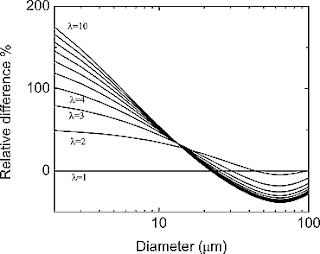It is widely know that dust is essentially non-spherical and hence radiative transfer calculations treating dust as a spherical particle are not adequate. A recent laboratory based study on dust particles by
Jingmin Li and
Kazuo Osada is very interesting. This article appeared in GRL this month. They study the preferential setting of elongated mineral dust collected from snow in a high mountain in Japan. The positions of particles' centers of gravity and folding centers are analyzed using a scanning electron microscopy and optical microscopy. Their results suggest that a preferential orientation exists for particles settling heavy side down (as expected) but what is interesting is the analysis of results from Ginoux's model wherein they apply this preferential orientation information and show that : " away from the source regions, dust particles are essentially spherical, which considerably simplify the calculation of settling velocity in transport and of radiative transfer models."

Figure above shows the relative difference of calculated settling velocity between ellipsoidal and spherical particles {Δu∞ = 100% × [u∞ (λ) − u∞ (λ = 1)]/u∞ (λ = 1)}. For example, the settling velocity of particles of 2 μm diameter increases respectively around 50%, 100%, and 165% for aspect ratios of 2, 4, and 10. The relative difference decreases with increasing particle size. For particles of 10 μm, the settling velocity increase for ellipsoids is around 30–40%, with little difference shown for aspect ratios of 1–10. On the other hand, a 40% decrease of settling velocity for ellipsoids is apparent at around 40–50 μm for the aspect ratio of 10.
Reference :
Li, J., and K. Osada (2007), Preferential settling of elongated mineral dust particles in the atmosphere, Geophys. Res. Lett., 34, L17807, doi:10.1029/2007GL030262.








No comments:
Post a Comment